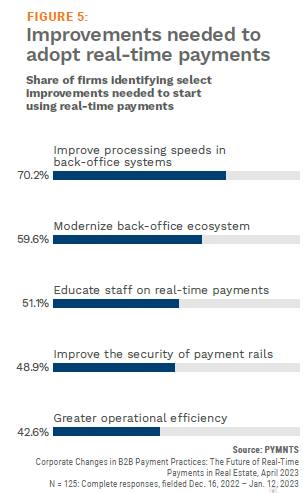Nearly 60% of Real Estate Firms Say Legacy Back Office Stalls Real-Time Payments Adoption

Real estate firms realize that adopting faster payment methods can help forge stronger vendor-supplier partnerships, which play a critical role in shaping the industry’s business-to-business (B2B) payments landscape.
In fact, 90% of those surveyed plan to start receiving payments in real time within the next year, as noted in PYMNTS’ “Corporate Changes in B2B Payment Practices: The Future of Real-Time Payments in Real Estate” report, which leverages insights from 125 executives at real estate firms with at least $100 million in annual revenue.

Apart from improving the relationship between real estate firms and their vendors and suppliers, the ability to pay quickly and on time, high security and protection of data as well as better cash flow management are cited in the report as some of the factors that make faster payments an attractive payment method in the B2B space.
However, despite the advantages offered by real-time payments, some real estate companies remain skeptical, pointing to obstacles that deter them from embracing this method.
“Chiefly, 62% of businesses cited the difficulty of replacing or updating legacy IT systems as a major barrier to adoption for making payments,” the report noted, with the high perceived cost of implementing real-time payments solutions for making payments following close behind, cited by 60% of firms.
Additionally, firms attributed their reluctance to difficulties associated with tracking payments and correcting errors, the limited number of buyers or suppliers using real-time payments and the increased risk of fraud due to the irreversibility of instant payments.
In addition to tackling these issues, the study found that most real estate firms require a significant revamp of their payment infrastructure to successfully transition to real-time payments — a fact acknowledged by a large share of companies.
In fact, 70% of real estate firms must ditch batch payment systems, 60% need to modernize their entire back-office procedures, and 51% need to educate staff on real-time payment systems — improvements which they say are required for them to start using real-time payments.

